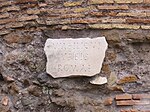Temple of Concord
2nd-century BC religious buildings and structures3rd-century BC religious buildings and structures4th-century BC religious buildings and structuresRoman temples by deity

The Temple of Concord (Latin: Aedes Concordiae) in the ancient city of Rome refers to a series of shrines or temples dedicated to the Roman goddess Concordia, and erected at the western end of the Roman Forum. The earliest temple is believed to have been vowed by Marcus Furius Camillus in 367 BC, but it may not have been built until 218 BC by L. Manlius. The temple was rebuilt in 121 BC, and again by the future emperor Tiberius between 7 BC and AD 10.
Excerpt from the Wikipedia article Temple of Concord (License: CC BY-SA 3.0, Authors, Images).Temple of Concord
Via dell'Arco di Settimio, Rome Municipio Roma I
Geographical coordinates (GPS) Address External links Nearby Places Show on map
Geographical coordinates (GPS)
| Latitude | Longitude |
|---|---|
| N 41.89293 ° | E 12.484245 ° |
Address
Tempio della Concordia
Via dell'Arco di Settimio
00184 Rome, Municipio Roma I
Lazio, Italy
Open on Google Maps








